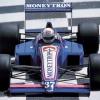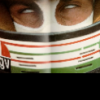
Starting lights procedure in F1
#1

Posted 11 August 2013 - 18:29
Now I'm wondering: since a flag was still used until the end of the 1970's, how come they waited so long to re-introduce this starting procedure? When was the 2nd time it was used? When did it become the standard system? I think that from 1980, possibly earlier, it was standard.
Advertisement
#2

Posted 11 August 2013 - 18:32
#3

Posted 11 August 2013 - 18:49
So they decided that the light going out would be it.
I am in the middle of PGA and Watkins Glenn, but would say the current is not more than seasons old at the most.
#4

Posted 11 August 2013 - 19:10
There were stories that the Ferrari's had some false starts in Monza in the 1960s and were allowed to do so as local officials turned a blind eye, don't know if that's another myth or if that really happened (in Itally I can imagine it occured at least once).
#5

Posted 11 August 2013 - 19:23
#6

Posted 11 August 2013 - 19:34
#7

Posted 11 August 2013 - 19:39
There were stories that the Ferrari's had some false starts in Monza in the 1960s and were allowed to do so as local officials turned a blind eye, don't know if that's another myth or if that really happened (in Itally I can imagine it occured at least once).
Regga "got off the line very well" in 1971. I won't go as far as saying he lapped the entire field before the race officially started, but it was pretty blatant to say the least.
#8

Posted 11 August 2013 - 20:15
Start procedure of GP...
Starting procedures
National flag and light-signal start system
National Flags at Grand Prix Starts
When was the green light on ?
The consensus seems to be that lights were used pre-war at the Belgian, German and Tripoli Grands Prix, but were not used for a World Championship GP until the 1975 British GP. They don't answer the question about why it took so long for them to be reintroduced post-war.
#9

Posted 11 August 2013 - 20:36
Edited by William Hunt, 11 August 2013 - 20:37.
#10

Posted 11 August 2013 - 22:05
The same way as you do/did with lights until someone came up with technology - which is that there are startline judges of fact who watch cars and flag (or light) and report any of the former that move before the flag drops or the light changes. In normal racing, as against the effone circus, that is still how it's done.And how could they check if a car made a false start when they used a flag?
#11

Posted 11 August 2013 - 22:19
#12

Posted 12 August 2013 - 03:35
#13

Posted 12 August 2013 - 06:58
Regga "got off the line very well" in 1971. I won't go as far as saying he lapped the entire field before the race officially started, but it was pretty blatant to say the least.
It was more like a rolling start for everyone
#14

Posted 12 August 2013 - 07:30
Some of the starts back then were comically amateurish.It was more like a rolling start for everyone

0:23, though
#15

Posted 12 August 2013 - 09:03
THe question seems to imply that starting with lights is in some way better than a flag. It's cleaner, tidier and nicely standardised but not necessarily better!What interests me is when they stopped using a flag and especially: why they didn't use lights in the '50s, '60s when it had already been used in 1935.
#16

Posted 12 August 2013 - 10:05
Quite so!THe question seems to imply that starting with lights is in some way better than a flag. It's cleaner, tidier and nicely standardised but not necessarily better!
As noted above some went on green but others went when the red went out. They seem to have stuck with the latter.
But then some went when the flag started its downward movement but others went when it was aloft having finished the upward movement! A quick up-and-down with no pause fixes that.
Oh and at Reims in flag days a local big-wig was used to drop the flag and some drivers went when the timekeeper's hand moved to touch the big-wig's back as the signal to drop the flag.
#17

Posted 12 August 2013 - 11:42
Of course, the main memory of Reims was the great Toto Roche, who would drop the flag when he considered it to be right, which could be any time after the 30 second board. If drivers weren't ready it was too bad for them. He once waved the flag when standing in the middle of the road and ran for his life. He survived, just.Oh and at Reims in flag days a local big-wig was used to drop the flag and some drivers went when the timekeeper's hand moved to touch the big-wig's back as the signal to drop the flag.
#18

Posted 12 August 2013 - 11:44
#19

Posted 12 August 2013 - 11:52
I know dragsters use the "Christmas tree", but when does their time start? And how do they define and detect a "jumped start?
Advertisement
#20

Posted 12 August 2013 - 14:11
Some of the starts back then were comically amateurish.
Bah, I'm actually a bit underwhelmed having seen it again. I remembered it more like this one:
#21

Posted 12 August 2013 - 20:18
I know dragsters use the "Christmas tree", but when does their time start? And how do they define and detect a "jumped start?
Their time starts when the car actually moves, not when the light turns green.
There is a laser light type system to determine if the driver leaves too early, a "staging light" with three sections, one section to show when they enter the beam, or "pre-stage" as it is called, at which point they have seven seconds to enter the "staged" section which trips the second section of the staging light (which is where you should be) and a third to indicate they are at the furthest point of the "staging" which is what they mean by "deep staged". That occurs when the car is at the furthest point of the staging beam and it is very easy to then false start or "red light" as it is called. The car is at the end of the light beam sector and even slight movement forward could be the point too far.
This reminds me of an old trick. A friend of mines dad and his brother and law were drag racers back when they still used a flag to start. In those days you were given three false starts before you were disqualified. They ran an underpowered car, a six cylinder and really didn't have much chance against most of the bigger engines. However, that six would run all day without overheating while the big motors would boil over rather quickly. So they would sometimes jump the start on purpose a couple of times, taking their time getting backed up, all the while the big motor in the other lane was overheating. He said you couldn't do it very often as they would catch on to what you were doing and toss you, and that it didn't work every time, but it did help them win quite a few races they shouldn't have.
#22

Posted 12 August 2013 - 20:27
that makes sense Allan but... are they using sensors nowadays in F1? I assume they are.
Yes they do. Charlie sits in his little box watching the controls which show a false start. I remember him fingering Alonso for do so a few years back. Also there was some fuss over Massa being lined up about halfway out of his box, but no penalty because sensors showed he did not leave early.
#23

Posted 13 August 2013 - 14:36
In those days you were given three false starts before you were disqualified.
That's the source of the problem; it should be "once over and out", then there would be no false starts.
#24

Posted 13 August 2013 - 17:59
That's the source of the problem; it should be "once over and out", then there would be no false starts.
Ah, but I suppose that is a matter of perspective. As my story shows, for some, it was a solution, not a problem.
#25

Posted 13 August 2013 - 20:04
Edited by William Hunt, 13 August 2013 - 20:13.
#26

Posted 13 August 2013 - 20:24
the question has been asked and discussed previously (without a definite conclusion). A list of links appears here. Or do searches for ["chequered flag" origin] and ["checkered flag" origin] - I think you need both spellings to be sure to find them all.I have another question, not related to the start flag (which was alwasy the national flag of the country where the race was held I assume) but about the finishing flag. In the early days of GP racing, the race was started with a black flag (I am 100% sure of this), now: when did they start to used a chequered black & white flag and why exactly chequered ?
Sometimes the start flag was a green flag - I can't remember when or where but suspect it could include Indianapolis.
Edited by D-Type, 13 August 2013 - 20:24.
#27

Posted 13 August 2013 - 20:29
Edited by Tim Murray, 13 August 2013 - 20:30.
#28

Posted 13 August 2013 - 21:37
#29

Posted 14 August 2013 - 07:17
I have experienced the series of lights that went out progressively also at GP meetings. That was ok but not as 'personal'
I still feel the green flag dropping or at least a green light going on is the best system.
#30

Posted 14 August 2013 - 08:28
Ah, but I suppose that is a matter of perspective. As my story shows, for some, it was a solution, not a problem.
Yes, of course! I was looking at it through the specs of a race official (and the fellow competitors), obviously.
#31

Posted 14 August 2013 - 13:22
Sometimes the start flag was a green flag - I can't remember when or where but suspect it could include Indianapolis.
Indianapolis was first started with a green flag in 1930, having always been a red flag previously.
#32

Posted 14 August 2013 - 13:41
Start lights
- sequence: red > yellow > green > start
- sequence: red > green > start
- sequence: red > off > start
Start flag
- national flag
- green flag
- black flag
- red flag
Finishing flag
- chequered (checkered) flag
- black flag
Any more variations? With place and date?
Edit: red - yellow - green sequence added
Edited by D-Type, 14 August 2013 - 15:05.
#33

Posted 14 August 2013 - 14:55




















